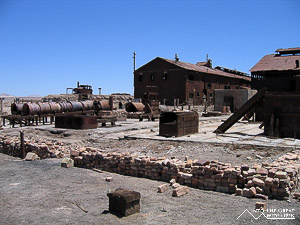Iquique, Chile
Surf, Sand, and Ghost Towns
March 4, 2008
And goodbye, fair weather home and your faithless factories
I have given you the blood and the truth from the wounds that they laid on me
And whatever they left, I kept it for my own heart
- The Gaslight Anthem

Iquique is one of those cities with such a dramatic setting that you will never forget the first time you see it. It is located about 4 hours south of Arica but the road runs right through the Atacama desert, a bone dry arid expanse of nothingness, before branching off at Humberstone, an old nitrate mining ghost town, to descend towards Iquique. The road winds downward through parched valleys and eventually reaches a small plateau between two taller mountains that extends in either direction high above the city. From here the ocean comes into view and you can see the entire city of Iquique narrowly confined between the coastline and the giant sand dune towering behind it.

The city itself is actually surprisingly interesting. With nitrate mining back in the early 1900s the city became very prosperous and there are still many old colorful mansions in various states of preservation or disrepair that were originally inhabited by the mining barons. The mansions have wooden clapboard siding and corrugated metal roofs that in many cases have been left intact and are corroded from the salt spray of the Pacific Ocean. While nitrate mining disappeared around 1960 with the discovery of a synthetic production method, Iquique still serves as an important port city and has a gigantic duty free shopping center with every kind of electronics good, alcohol, perfume, or clothes that you could want at fairly good prices. That is the interesting part of Iquique, the rest of the city is basically a modern and expensive beach resort with high-rise condos and hotels, essentially it could be anywhere in California if not for the unique and spectacular setting. With the mountains surrounding the city, there are numerous signs for tsunami evacuation routes because if there ever were a tsunami it would entirely destroy the city because the waves would wash inland, deflect off the tall sand dune, flood the city, and drag it out to sea.

At the road turn-off to Iquique there are the remnants of industries of the past with Humberstone and Santa Laura. I took a collectivo from Iquique and had the driver drop me off at the entrance to Santa Laura. There was a small rundown museum with some interesting artifacts that were found at the site. In the mid-day heat I walked around the ruins that contained much of the machinery that was used in the mining operations, rusted over but still in the original position. The area immediately around the big skeleton of the main building is fenced off because it is fairly unstable and with the earthquakes that occur in the area (there was a 5.6 earthquake a few weeks back) it could collapse. Walking around the site there were pieces of rusted metal and broken glass everywhere, there certainly hadn´t been any effort to clean up the site. There were even the remnants of an old dusty soccer field with rusted metal goals struggling to stay up.

From Santa Laura I walked about a mile through the desert under the roasting sun to Humberstone. Humberstone was suprisingly large and almost all of it, save for a few buildings that had been restored, were in the original state. In the main plaza there is a building with all of the interesting bottles, cans, books, and other everyday items that had been found, some preserved amazingly well. Other than those, all the buildings were completely empty, long since stripped clean of anything of value or use. The town had been rather prosperous with a large theater for movies and plays and a swimming pool made from the bolted together metal segments of ship hulls; it even was complete with a diving platform, although I’m not sure where the water would have come from. Behind the town, further off the main road, are the mining buildings with all the old mining equipment. I was the only person of the few people visiting Humberstone to actually venture back there and it was eerie to walk through such a large deserted complex alone.

After wandering through the site I walked back to the road and waited for a bus or collectivo to pass by to hitch a ride back to Iquique. Luckily I didn´t have to wait long and I flagged down the first bus that passed. It just happened to be the exact same bus that I had arrived on from Arica on the previous day so the driver and attendant both recognized me, quite the coincidence. I headed to the bus station to get a ticket south to go to Tocopilla and I was disappointed to hear that the earthquake back in October had caused a tunnel on the route to collapse and it still hadn´t been repaired so the route along the coast was closed and I would have to take the much less scenic desert route, but at least it was only a five hour ride.


































































